Picture this: a kitchen sink that’s not just a basin but a game-changer for your daily chores. That’s what I found with Franke sinks, and I’m here to tell you why you need one in your life.
As someone who’s spent years scrubbing pots and soaking dishes, I can say Franke delivers style, durability, and functionality that make kitchen tasks feel less like work.
In this article, I’ll share my experience, break down the pros and not-so-good parts, compare Franke to other brands, and give you maintenance tips to keep your sink shining. Trust me, you’ll want a Franke sink by the end.
My Experience With Franke Sinks
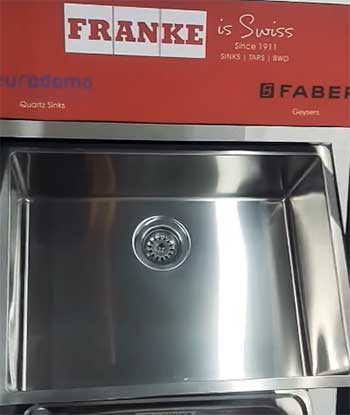
When I remodeled my kitchen last year, choosing a sink was a bigger decision than I expected.
I wanted something that looked sleek, handled heavy-duty tasks, and didn’t turn into a maintenance nightmare.
After researching and comparing options, I settled on the Franke Pescara stainless steel single-bowl sink, and let me tell you, it’s been a revelation.
From the moment it was installed, I noticed how it elevated my kitchen’s vibe.
The brushed stainless steel finish gives it a modern, almost industrial charm that pairs perfectly with my quartz countertops. It’s not just about looks, though—using it feels like a dream.
The first thing that struck me was the depth. At 9 inches, the basin easily swallows up my biggest pots and baking trays. I used to dread washing my Dutch oven in my old, shallow sink because water would splash everywhere. With the Pescara, I can fill it up, scrub away, and not worry about turning my counters into a splash zone.
The sound-dampening pads are another win. My old sink sounded like a drum set every time I dropped a spoon, but this one keeps things quiet, even when I’m tossing in heavy cookware. It’s like Franke thought of everything to make my kitchen time less chaotic.
I also love the concealed drain design. It’s not just aesthetically pleasing; it keeps glassware stable when I’m washing delicate items. The shelf grid accessory is a lifesaver for small kitchens like mine. I can rinse veggies or stack dishes without cluttering my counters.
Sure, the sink wasn’t cheap, but the quality feels worth every penny. It’s been a year, and it still looks as good as the day it was installed, with minimal effort on my part. My only gripe? It shows water spots if I don’t dry it, but that’s a small price to pay for a sink that makes me enjoy doing dishes—well, almost.
Pros of Franke Sinks
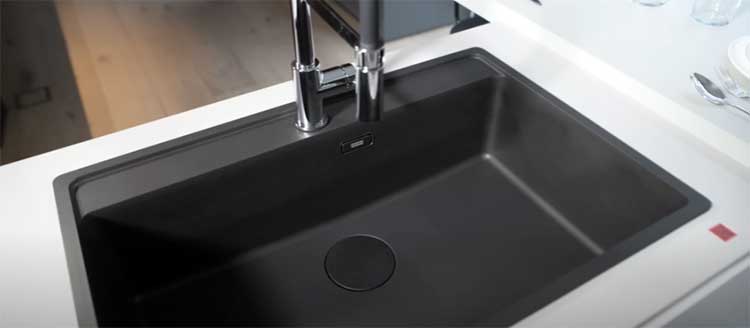
- Exceptional Build Quality
Franke sinks are built to last, and I can feel it every time I use mine. Whether it’s stainless steel, granite composite, or fireclay, the materials are top-notch. My stainless steel Pescara is 18-gauge, which is plenty sturdy for home use, but Franke also offers 16-gauge options for those who want even thicker steel.
The granite composite models, like the Franke Ellipse, use 80% quartz, making them incredibly durable and resistant to heat and scratches. I’ve dropped knives and hot pans in my sink without a single dent or mark. It’s like Franke engineered these sinks to handle whatever you throw at them.
- Stylish Design Options
Let’s talk aesthetics—you want a sink that makes your kitchen pop, right? Franke delivers with a range of designs that suit any style. My Pescara’s brushed finish gives my modern kitchen a sleek edge, but if you’re into a classic look, their fireclay farmhouse sinks, like the FHK710-33WH, are stunning.
They also offer granite composite sinks in colors like onyx and graphite, which blend seamlessly with bold or neutral countertops. I’ve seen friends pair their Franke sinks with white, black, and even wood countertops, and the result is always a showstopper. You’re not just buying a sink; you’re investing in a focal point.
- Practical Features for Everyday Use
Franke sinks are packed with thoughtful features that make life easier. The deep bowls are a godsend for anyone who cooks big meals—I can soak a whole tray of lasagna dishes without issue. The offset drain in my Pescara maximizes usable space, so I’m not wrestling with a centered drain clogging up my workflow.
Many models come with accessories like shelf grids, chopping boards, and roll mats, turning your sink into a multitasking hub. I use the shelf grid daily for prep work, and it’s saved me so much counter space.
Plus, the sound-dampening tech keeps noise to a minimum, which is a blessing if you have an open-plan kitchen.
- Easy Installation Options
Installing my Franke sink was a breeze, thanks to their Fast-IN system. The clips made it simple for my contractor to secure the sink without a fuss, whether as an undermount or drop-in. I’ve heard horror stories about sink installations taking hours, but mine was done in under an hour.
Franke provides clear instructions and hardware, so even if you’re a DIY enthusiast, you won’t be sweating bullets. For trickier setups, like farmhouse sinks, you might need a pro, but Franke’s design ensures compatibility with various cabinet sizes, making it less of a headache.
- Long-Term Durability with Great Warranties
One thing that sold me on Franke was their warranty. My stainless steel sink came with a lifetime warranty against manufacturing defects, which gave me peace of mind. Their granite composite sinks often have 50-year warranties, and even the fireclay models offer solid coverage.
After a year of heavy use—think daily cooking, soaking, and scrubbing—my sink still looks pristine. The materials are designed to withstand wear and tear, so you’re not just buying a sink; you’re making a long-term investment in your kitchen.
Not-So-Good Parts of Franke Sinks
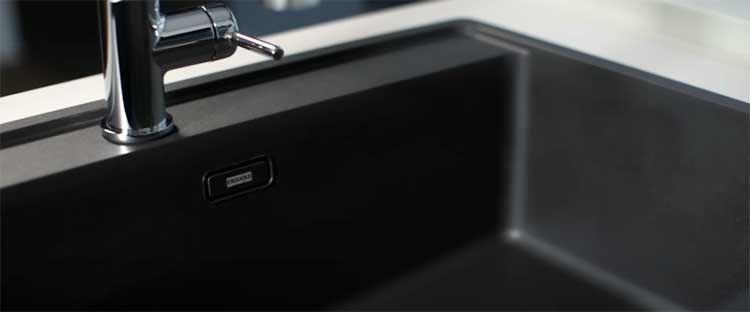
- Premium Price Point
Let’s be real—Franke sinks aren’t budget buys. My Pescara set me back more than I initially planned to spend, and their fireclay or high-end granite models can cost even more. Compared to brands like Kraus, which offer similar features at a lower price, Franke might feel like a splurge.
That said, I think the quality justifies the cost, especially if you’re in it for the long haul. If your budget is tight, you might need to shop around for deals or consider their more affordable stainless steel options.
- Water Spots and Fingerprints
My stainless steel Pescara looks gorgeous, but it’s a magnet for water spots and fingerprints. If I don’t dry it after use, I’m left with a speckled mess that dulls the shine. This is especially annoying in a hard-water area like mine, where limescale can build up if you’re not diligent.
Granite composite sinks, like the Franke Basis, can also show water marks, particularly in darker finishes. It’s not a dealbreaker, but it means you’ll need to wipe down the sink regularly to keep it looking flawless.
- Limited Material Variety
While Franke offers stainless steel, granite composite, and fireclay, their material range isn’t as diverse as some competitors. Brands like Blanco have copper or ceramic options, which might appeal to those wanting something unique.
I love my stainless steel sink, but if I’d wanted a bold material like copper, I’d have had to look elsewhere. Franke’s focus on quality over quantity is clear, but it might disappoint if you’re after something outside their core offerings.
- Installation Challenges for Some Models
While my Pescara was easy to install, some Franke models, like the farmhouse sinks, can be trickier. The FHK710-33WH, for instance, is heavy due to its fireclay construction, and you’ll need a custom cabinet setup. I’ve heard from friends who needed professional help, which added to the cost.
If you’re replacing an existing sink with a different style, like switching from a drop-in to an undermount, expect some extra plumbing work. It’s not Franke’s fault, but it’s something to consider if your kitchen setup isn’t flexible.
Maintenance Tips For Franke Sinks
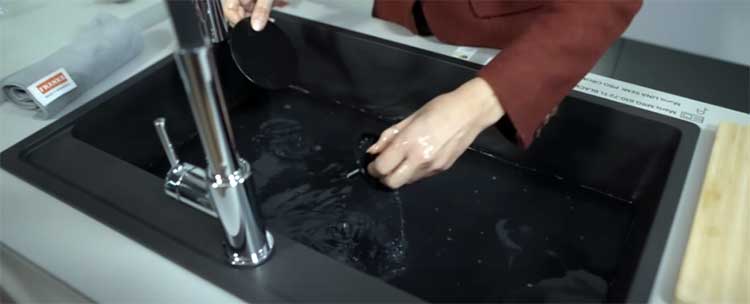
- Daily Cleaning Routine
Keeping your Franke sink sparkling is easier than you’d think, but it takes a bit of consistency. After each use, I rinse mine with warm water to wash away food bits and prevent stains. Then, I use a soft sponge with a dab of mild dish soap to clean the surface.
Drying it with a microfiber cloth is key to avoiding water spots, especially on stainless steel. It takes me maybe two minutes, but it keeps the sink looking brand new. For granite composite sinks, the same routine works, but avoid abrasive scrubbers—they can dull the finish.
- Tackling Limescale and Hard Water Stains
If you live in a hard-water area like I do, limescale can be a pain. I’ve found that a weekly deep clean with a non-abrasive cleaner, like Bar Keepers Friend, works wonders. For stubborn limescale, I soak a cloth in white vinegar, lay it on the affected area for 10 minutes, then rinse and dry.
For granite or fireclay sinks, check Franke’s guidelines, as some materials need specific cleaners. Never use bleach on granite composite—it can damage the surface. This routine keeps my sink free of that chalky buildup.
- Preventing Scratches and Dents
To keep scratches at bay, I always use a sink grid or mat when washing heavy pots. My Pescara’s satin finish hides minor scratches well, but deeper ones can happen if you’re careless. For granite sinks, Franke’s quartz-heavy composite is naturally scratch-resistant, but I still recommend using a grid for peace of mind.
Avoid dragging sharp objects across the surface, and don’t drop heavy items—while Franke sinks are tough, they’re not indestructible. A little caution goes a long way in preserving that sleek look.
- Maintaining Accessories
Franke’s accessories, like shelf grids and chopping boards, are super handy but need care too. I clean my shelf grid with soap and water after each use to prevent food buildup. For wooden accessories, like cutting boards, I apply mineral oil monthly to keep them from drying out.
Check for wear on rubber components, like drain covers, and replace them if they start to crack. Storing accessories properly—dry and away from dampness—extends their life. Franke’s website has specific care tips for each accessory, so it’s worth a quick look.
- Periodic Deep Cleaning
Every month or so, I give my sink a thorough clean to restore its shine. For stainless steel, I sprinkle a bit of baking soda, scrub gently with a damp sponge, and rinse. For an extra glow, I wipe it with a cloth dipped in a mix of water and a splash of vinegar.
Granite sinks benefit from a similar treatment, but I use a composite-safe cleaner to avoid dulling the surface. Fireclay sinks, like the FHK710-33WH, can handle a light scrub with a mild abrasive, but always rinse thoroughly. This keeps my sink looking like it just came out of the box.
Comparison of Franke Sink With Other Brands
I’ve pitted my Franke Pescara against sinks from Create Good Sinks, Karran Sinks, and Kraus Sinks to see how they measure up. Each comparison focuses on key factors that matter to me as a user.
- Franke Pescara Vs. Create Good Sinks Signature Series
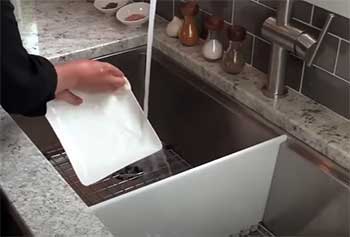
The Franke Pescara’s 18-gauge stainless steel feels rock-solid, and its lifetime warranty gives me confidence it’ll last.
The Create Good Sinks Signature Series, often in 20-gauge steel, is lighter and more affordable but feels less sturdy when I’ve used one at a friend’s house.
Franke’s offset drain maximizes usable space, while Create Good’s centered drain can get in the way of soaking large pans. Design-wise, Franke’s brushed finish looks polished, whereas Create Good’s finish showed more fingerprints in my experience.
Create Good includes basic accessories, but Franke’s shelf grid and roll mats are more versatile for multitasking.
- Franke Pescara Vs. Karran Quartz Q-350
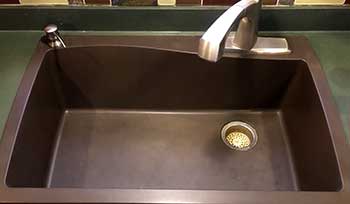
Karran’s Quartz Q-350 composite sink is a strong contender with its 80% quartz construction, similar to Franke’s Ellipse.
Both resist scratches and heat well, but I find Franke’s surface smoother and less prone to staining.
The Pescara’s stainless steel is easier to clean than Karran’s matte finish, which can trap grime if not maintained.
Karran’s sinks are slightly cheaper, but Franke’s Fast-IN system made installation a breeze compared to Karran’s more involved setup.
Franke’s sound-dampening pads also keep things quieter than Karran’s, which I noticed when washing heavy pots at a relative’s house.
- Franke Pescara Vs. Kraus KHU100-30
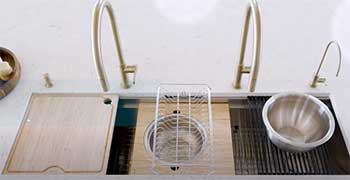
Kraus’s KHU100-30 is a popular choice with its 16-gauge stainless steel, thicker than my Pescara’s 18-gauge.
It feels hefty, but I’ve read about occasional dents under heavy use, which hasn’t been an issue with my Franke.
Both brands offer sound-dampening, but Franke’s concealed drain design gives it a cleaner look and more stable base for glassware compared to Kraus’s centered drain. Kraus bundles accessories like strainers, which is nice, but Franke’s optional shelf grid adds more prep space.
Price-wise, Kraus is often cheaper, but Franke’s lifetime warranty and refined finish make it feel more premium.
Frequently Asked Questions (FAQ)
Absolutely, Franke is a fantastic brand for sinks. I’ve been thrilled with my Pescara’s durability, design, and ease of use. Franke’s been in the game since the 1930s, and their reputation for quality is well-earned. Whether you choose stainless steel, granite composite, or fireclay, you’re getting a sink built to handle daily wear while looking great. Their lifetime warranties on stainless steel and long coverage on other materials seal the deal. If you want a sink that’s both practical and stylish, Franke’s a solid choice.
Franke sits in the upper-mid to high-end range, depending on the model. My Pescara wasn’t cheap, but it’s not as pricey as some ultra-luxury brands like Kohler’s top-tier sinks. Franke’s fireclay farmhouse sinks, like the FHK710-33WH, lean more high-end due to their handcrafted materials and design. The brand’s focus on premium materials, innovative features, and long warranties gives it a high-end feel without breaking the bank. You’re getting near-luxury quality at a price that’s often more accessible than competitors.
From my experience, Franke sinks are pretty scratch-resistant, but it depends on the material. My stainless steel Pescara has a satin finish that hides minor scratches well—I’ve dropped utensils and pots without noticeable marks. Granite composite sinks, like the Ellipse, are even tougher, thanks to their 80% quartz makeup. Fireclay models are also durable but can chip if you’re rough with heavy items. Using a sink grid, like I do, prevents most scratches. With a little care, Franke sinks stay looking pristine.
You can use bleach sparingly on stainless steel and fireclay Franke sinks, but I’d avoid it on granite composite models. I’ve used a diluted bleach solution (1:10 with water) on my Pescara for tough stains, followed by a thorough rinse, and it’s fine. For granite sinks, bleach can dull the finish over time, so I stick to vinegar or composite-safe cleaners. Always check Franke’s care guidelines for your specific model. To be safe, test any cleaner in a small area first to ensure it doesn’t affect the surface.
Conclusion: Why You Should Buy A Franke Sink?
After a year with my Franke sink, I can’t imagine going back to anything less. It’s durable, stylish, and makes kitchen tasks a breeze with its deep bowls and smart features.
Whether you’re washing dishes or prepping a feast, Franke’s quality and design elevate the experience. From stainless steel to fireclay, there’s a model for every kitchen, backed by stellar warranties. If you want a sink that’s worth every penny and transforms your kitchen, grab a Franke—you won’t regret it.
